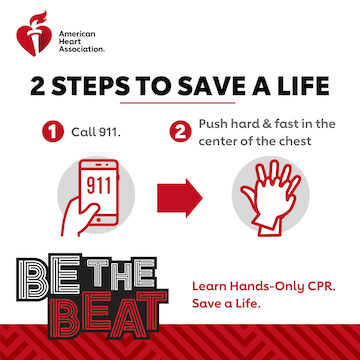American Heart Month, Black History Month
Nearly 90% of the 350,000 people who experience a cardiac arrest outside of a hospital each year will not survive. Less than half of people who need it will receive the immediate help that they need before professional help arrives. To change these alarming statistics, the American Heart Association, a global force for healthier lives for all, is challenging every household to have at least one person know CPR and Be The Beat for their family, friends, and community during American Heart Month and Black History Month in February.
CPR – or cardiopulmonary resuscitation – is an emergency lifesaving procedure performed when the heart stops beating. Since nearly 3 out of 4 cardiac arrests that do not happen in a hospital, occur in the home, if you are called on to give CPR in an emergency, you will most likely be trying to save the life of someone you know or love. Immediate CPR can double or triple chances of survival after cardiac arrest. Keeping the blood flow active – even partially – extends the opportunity for a successful resuscitation once trained medical staff arrive on site.
There are two commonly known versions of CPR. Healthcare providers and those who have been trained use conventional CPR using chest compressions and rescue breathing. General public or bystanders who see a teen or adult suddenly collapse at home, at work, or elsewhere, can use compression-only CPR, or Hands-Only CPR, compressions without mouth-to-mouth breaths. The Association still recommends CPR with compressions and breaths for infants and children and victims of drowning, drug overdose, or people who collapse due to breathing problems.
“When people learn Hands-Only CPR, they see how simple the technique is and gain comfort that may help them overcome concerns that previously may have caused them to hesitate - rather than take life-saving action - in an emergency,” said American Heart Association volunteer President Michelle A. Albert, M.D., M.P.H., FAHA, the Walter A. Haas-Lucie Stern endowed chair in Cardiology, professor of medicine and admissions dean at University of California-San Francisco School of Medicine. “It is important to note that Black Americans have the highest incidence of cardiac arrest outside of the hospital and are significantly less likely to survive. Cardiac arrest in Black neighborhoods is associated with alarmingly low treatment and survival rates and studies have shown lower rates of both bystander CPR and bystander AED use in these neighborhoods. We need to change this trajectory,”
 Additionally, researchers have determined that language barriers for non-English 9-1-1 callers and challenges from a lack of bilingual dispatchers during dispatcher-identified cardiac arrest are also associated with less frequent bystander CPR, as well as delays in both cardiac arrest recognition and implementation of telecommunicator CPR.
Additionally, researchers have determined that language barriers for non-English 9-1-1 callers and challenges from a lack of bilingual dispatchers during dispatcher-identified cardiac arrest are also associated with less frequent bystander CPR, as well as delays in both cardiac arrest recognition and implementation of telecommunicator CPR.
Men are more likely to receive bystander CPR in public locations compared to women. Women and men receive similar CPR assistance within the home, but in public 45% of men received assistance compared to only 39% of women. In fact, for men, their chance of survival was 23% higher compared to women. So why the discrepancy? It could come down to anatomy and a bystander being comfortable enough to perform CPR on a woman.
TAKE THE CPR CHALLENGE
When seconds matter most, CPR can be the difference in whether your friends and family survive. But not everyone knows how to perform CPR. The American Heart Association is challenging every household or family to learn Hands-Only CPR through just two simple steps, performed in this order: 1) Call 911 if you see a teen or adult suddenly collapse; and 2) Push hard and fast in the center of the chest to the beat of a familiar song that has 100 to 120 beats per minute. Some examples are “Stayin’ Alive” by the Bee Gees, “Crazy in Love” by Beyoncé featuring Jay-Z, “Hips Don’t Lie” by Shakira” or “Walk the Line” by Johnny Cash. The American Heart Association CPR playlist offers numerous selections to help you Be The Beat.
You can also watch a 90-second Hands-Only CPR instructional video and share it. Even better, watch it with your friends and family so you all learn together. Or, find a nearby class to take a course to learn the lifesaving skills of CPR, first aid, and AED.












